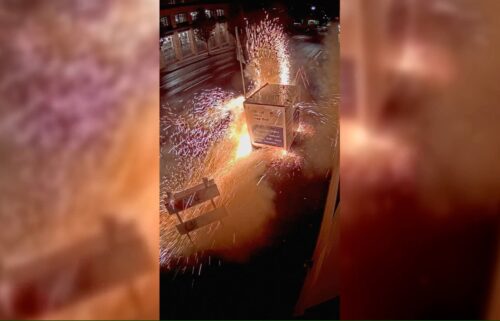Pentagon tracked failed Iranian satellite launch and new images reveal Tehran is set to try again
By Zachary Cohen and Oren Liebermann, CNN
The Pentagon was watching as Iran attempted, and failed, to launch yet another satellite into orbit earlier this month, multiple defense officials tell CNN.
But while that previous effort, which took place in mid-June, was unsuccessful, Iran appears to be preparing for another attempt in the near future, as satellite imagery captured by commercial firms Planet and Maxar shows increased activity at Imam Khomeini Spaceport in recent days, according to experts at the Middlebury Institute of International Affairs at Monterey who analyzed the photos.
Fuel containers, support vehicles and a mobile platform are visible in satellite images taken of the site as recently as June 20, which the experts at Middlebury say is a key indicator that another launch could be attempted in the coming days or weeks.
The images also show increased vehicle activity at the Khomeini launch site, located nearly 200 miles east of Tehran, which experts say is another sign of a potentially imminent launch.
“U.S. Space Command is aware of the Iranian rocket launch failure which occurred early June 12th,” Pentagon spokesman Lt. Col. Uriah Orland said in a statement to CNN. It was unclear why the launch was unsuccessful and at exactly what stage it failed, officials said. Previous Iranian attempts at launching satellites into orbit have blown up on the launchpad or failed at a later stage.
The increased activity at Iran’s spaceport comes at a critical time in relations between Tehran and Washington. The two countries are in sensitive negotiations for a return to the Iran nuclear agreement, known as the Joint Comprehensive Plan of Action (JCPOA), and the potential easing of sanctions against Iran. The activity also comes in the final weeks of the term of President Hassan Rouhani, before he is replaced by the ultra-conservative judiciary chief Ebraham Raisi in August.
While the US defense officials did not identify the rocket that was used in the launch earlier this month, Jeffrey Lewis, a professor at the Middlebury Institute of International Studies, said it was likely the Simorgh rocket, a two-state space launch vehicle using engines based on a North Korean design.
“The failed launch attempt is the fourth consecutive failure of the Simorgh launcher,” said Lewis, author of an upcoming book on Iran’s space program. “Iran seems to be struggling with this specific system. Other Iranian rockets of different designs have been more successful.”
Critics of Iran see the satellite launches as a provocative step, since the rockets use technology similar to what is needed for intercontinental ballistic missiles (ICBMs).
“The Iranians have a long history of conflating the commercial and the military,” said Bradley Bowman, senior director at the Center on Military and Political Power at the hawkish Foundation for Defense of Democracies think tank. “Anything that Iran is doing in space I would be concerned about, because they are going to … use those same capabilities against us in a military conflict.”
After last April’s launch, Fabian Hinz, an independent open source analyst focusing on Middle East missiles, noted the technological developments. “Whereas Iran’s civilian program uses launchers badly suited for conversion to ballistic missiles, the IRGC’s seems intent on developing launcher technology applicable to long-range missile development and more or less subtly signaling these capabilities,” he wrote at the time.
The latest launch, conducted on June 12, comes more than one year after the country’s last attempt to put a satellite into orbit. In April of last year, Iran launched the Nour 01 military satellite into orbit after previous failed attempts to launch similar satellites in a move that revealed a military aspect to the country’s civil space program. Iran’s Islamic Revolutionary Guard Corps claimed the launch had been successful, but the commander of US Space Command, Gen. Jay Raymond, quickly dismissed the assertion.
“Iran states it has imaging capabilities—actually, it’s a tumbling webcam in space; unlikely providing intel,” Raymond said on Twitter a few days after the launch.
US Space Command tracked two objects from the launch: the Nour satellite and the rocket body. The satellite remains in orbit, but the Pentagon believes it is not usable.
“Iran’s last space launch took place in April 2020, and placed a simple microsatellite (NOUR-1) in orbit which U.S. Space Command continues to track. However our persistent observations of this object demonstrate it is uncontrolled and not operational,” said Pentagon spokesman Lt. Col. Uriah Orland in a statement to CNN on Tuesday.
Now Iran appears set to try again.
“Iran announced three space launches this year using the Simorgh. The fact that they are trying again so quickly says a lot about how much the space program wants a success,” Lewis said.
Nevertheless, Lewis suggested Iran would develop a different rocket if it pursued ICBMs, saying, “The Simorgh is huge and uses engines that are basically super-sized Scud engines, which are pretty inefficient. If Iran wanted to build an ICBM, it would follow North Korea’s path and build an ICBM with a better engine or motor and small enough to be transported by a truck.”
In the past, Iran’s space program has been plagued by a series of failures and mishaps that have prevented the country from effectively placing a satellite into orbit.
In August 2019, an Iranian rocket exploded on its launch pad at the Khomenei Spaceport in Semnam. One month later, the Trump administration imposed sanctions on the Iranian Space Agency (ISA) for the first time ever.
In January 2019 and July 2017, the Iranian Space Agency launched a two-stage space launch vehicle, but both launches failed to put a satellite into orbit.

